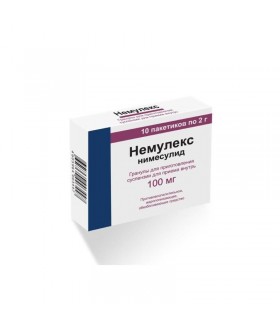




Security policy (edit with Customer reassurance module)

Delivery policy (edit with Customer reassurance module)

Return policy (edit with Customer reassurance module)
10 pieces
Nemulex has anti-inflammatory, analgesic, antipyretic and angiogregatory effects. Unlike other NSAIDs, it selectively inhibits COX-2, inhibits the synthesis of PG in the focus of inflammation; It has a less pronounced inhibitory effect on COX-1 (rarely causes side effects associated with inhibition of GHG synthesis in healthy tissues).
rheumatoid arthritis;
osteoarthritis;
arthritis of various etiologies;
arthralgia;
myalgia;
postoperative and post-traumatic pains;
bursitis;
tendonitis;
algomenorrhea;
toothache and headache.
hypersensitivity;
complete or incomplete combination of bronchial asthma, recurrent nasal polyposis or paranasal sinuses and intolerance to Acetylsalicylic acid (ASA) and other NSAIDs (including a history of);
erosive and ulcerative lesions of the mucous membrane of the stomach and duodenum;
active Gastrointestinal bleeding;
bleeding, incl. cerebrovascular;
inflammatory bowel disease (Crohn's disease, ulcerative colitis) in the acute phase;
hemophilia and other bleeding disorders;
decompensated chronic heart failure (CHF);
liver failure or any active liver disease;
hepatotoxic reactions with the use of Nimesulide in history;
alcoholism;
addiction;
severe chronic renal failure (CRF) (creatinine Cl
progressive kidney disease;
confirmed hyperkalemia;
the period after coronary artery bypass surgery;
simultaneous reception of other hepatotoxic drugs;
children up to 12 years;
pregnancy;
breastfeeding period.
Inside Contents 1 pack. dissolved in 80-100 ml of water. The recommended dose for adults and adolescents aged 12–18 years is 100 mg (1 pack.) 2 times a day after meals. The maximum daily dose for adults and adolescents aged 12–18 years is 200 mg. No dose reduction is required for elderly patients. Patients with chronic renal failure require a reduction in the daily dose to 100 mg.
The minimum effective dose should be administered for as short a period as possible in order to minimize the risk of adverse reactions. The maximum duration of the drug should not exceed 15 days.
Allergic reactions: hypersensitivity reactions, anaphylactoid reactions.
From the side of the central nervous system: dizziness, feeling of fear, nervousness, nightmares, headache, drowsiness, encephalopathy (Reye's syndrome).
From the skin: itching, skin rash, increased sweating, erythema, dermatitis, urticaria, angioedema, swelling of the face, erythema multiforme exudative, including Stevens-Johnson syndrome, toxic epidermal necrolysis (Lyell's syndrome).
Urogenital: edema, dysuria, hematuria, urinary retention, renal failure, oliguria, interstitial nephritis.
From the digestive tract: diarrhea, nausea, vomiting, constipation, flatulence, gastritis, abdominal pain, stomatitis, tarry stools, gastrointestinal bleeding, ulcers and / or perforation of the stomach or duodenum.
Liver and biliary system: elevation of hepatic transaminases, hepatitis, fulminant hepatitis, jaundice, cholestasis.
From the side of blood and blood-forming organs: anemia, eosinophilia, thrombocytopenia, pancytopenia, purpura, lengthening of bleeding time.
Respiratory: dyspnea, exacerbation of asthma, bronchospasm.
Special senses: blurred vision.
From the CCC: arterial hypertension, tachycardia, hemorrhages, hot flashes.
Other: general weakness, hypothermia, hyperkalemia.
There is evidence that nimesulide can reduce the bioavailability of Furosemide, to compete in the binding of plasma proteins with fenofibrate, salicylic acid, tolbutamide. Nimesulide can replace salicylic acid and furosemide (but not warfarin) in connection with plasma proteins. It has no effect on drugs that affect blood glucose concentration and glucose tolerance in diabetic patients who receive sulfonylurea derivatives. It is not recommended to take nimesulide at the same time as diuretics that violate renal hemodynamics.
Physiological concentrations of unsaturated fatty acids do not affect the binding of nimesulide to serum albumin. At therapeutic concentrations, the binding of nimesulide was not affected by Warfarin, furosemide, glibenclamide, digitoxin. In the presence of nimesulide, the free fraction of Methotrexate can increase significantly.
Taking nimesulide in therapeutic doses orally for a short period does not change the serum profile of Digoxin in patients with mild heart failure.
The concentration of lithium in the plasma increases while taking drugs of lithium and nimesulide. Nimesulide may enhance the effect of cyclosporine on the kidneys. Use with GCS, serotonin reuptake inhibitors increases the risk of gastrointestinal bleeding.
Symptoms: nausea, vomiting, drowsiness, apathy, gastrointestinal bleeding, increased blood pressure, acute renal failure, respiratory depression.
Treatment: symptomatic and supportive treatment is recommended. There is no specific antidote. Patients admitted to hospital with symptoms of an overdose of the drug (within 4 hours after taking it or after taking a high dose) are recommended to wash the stomach, take Activated carbon (60–100 mg for adults) and / or osmotic laxatives. Requires regular monitoring of liver and kidney function. There is no data on the possibility of removing nimesulide using hemodialysis. Forced diuresis, hemodialysis are ineffective due to the high association of the drug with proteins.
In a dry, dark place at a temperature of no higher than 25 ° C.
Nemulex